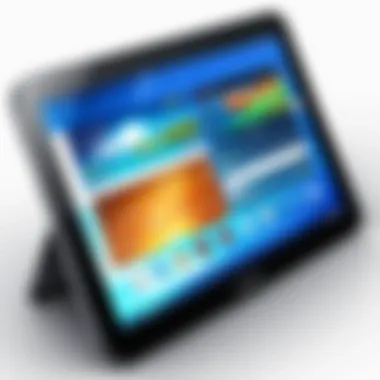Samsung Galaxy Tab 2 10.1 Pricing Analysis and Insights


Intro
The market for tablets has evolved significantly over the years. One prominent device in this landscape is the Samsung Galaxy Tab 2 10.1. Understanding its pricing is essential for both consumers and market analysts. This section will provide a foundation for the subsequent exploration of price dynamics and their implications.
Pricing is influenced by various factors such as technology specificities, competitive pressures, and consumer demand. The Galaxy Tab 2 10.1 was launched at a time when the tablet market was becoming increasingly competitive. Examining its pricing gives insights into how Samsung positioned this product against rivals.
Product Overview
Brand information
Samsung, a leader in the technology sector, is known for its innovation and quality in electronic devices. The Galaxy Tab line represents their foray into the tablet market, offering versatile devices tailored for productivity and entertainment.
Key specifications
The Samsung Galaxy Tab 2 10.1 features a display size of 10.1 inches, powered by a dual-core processor. It operates on Android, providing a rich application ecosystem. Key specifications include:
- Display: 1280 x 800 pixels
- Processor: Dual-core 1 GHz Cortex-A9
- RAM: 1 GB
- Storage Options: 16/32 GB with expandable memory via microSD
- Camera: 3.15 MP rear and 0.3 MP front
Pricing
At launch, the Samsung Galaxy Tab 2 10.1 was priced competitively within the tablet segment. Current market prices vary based on condition, storage capacity, and retailer offers. As of 2023, prices range around $150 to $300 depending on these factors.
Performance Comparison
Benchmark tests
Performance is a critical aspect when considering a tablet. The Galaxy Tab 2 10.1, while not leading-edge by today's standards, offers decent performance for most applications. Benchmark tests indicate satisfactory results for general use. However, it may lag behind newer models with more advanced processors.
Speed and efficiency comparisons
In comparison to its contemporaries, the Galaxy Tab 2 holds up reasonably well in everyday tasks like browsing and media consumption. Yet, in heavy multitasking scenarios, user experience may suffer due to its limited RAM. It effectively handles tasks, but the efficiency remains just adequate.
Features and Technology
Unique features
One of the key selling points of the Galaxy Tab 2 10.1 is its integrated features like the Samsung Hub, which provides access to various content such as music and videos. Its dual speakers enhance audio quality for entertainment purposes.
Technological advancements
While it lacks some newer technology features found in current tablets, it introduced innovations like Samsung's TouchWiz interface which improved user experience and customization options.
Compatibility with other devices
This tablet supports a range of accessories, enhancing functionality. Its compatibility with Samsung's ecosystem allows for seamless integration with smartphones and smart TVs.
Pros and Cons
Strengths of the product
- Good display quality
- Expandable storage
- Affordable compared to newer models
Areas for improvement
- Limited RAM impacts multitasking
- Older Android version limits access to recent applications
- Weaker camera performance compared to current standards
Value for Money


Cost-effectiveness
For budget-conscious consumers, the Galaxy Tab 2 10.1 presents an accessible option for basic tablet use. It provides sufficient performance for tasks such as reading, light gaming, and streaming content.
Long-term benefits
Understanding that the device is not leading-edge, it still has a place for users who do not require the most advanced technology. Those looking for a simple and reliable tablet may find it worthwhile.
Comparison with similar products
When compared to competitors like the Acer Iconia Tab A200 or the Asus Nexus 7, the Galaxy Tab 2 10.1 offers similar capabilities at a competitive price but may lack certain features found in newer models. This makes it a balanced choice for specific target segments.
Foreword to Samsung Galaxy Tab 10.
The Samsung Galaxy Tab 2 10.1 holds a significant place in the evolution of tablets. Launched in 2012, this device was an attempt by Samsung to establish its brand in a rapidly growing market dominated by Apple. Analyzing the pricing of this tablet is essential for understanding its positioning and acceptance in the marketplace. Through this examination, readers can grasp not just the numbers, but also the contextual elements that have shaped its pricing strategy over time.
This section aims to present an overview that frames the Galaxy Tab 2 10.1 within the broader tablet ecosystem. First, it is crucial to recognize that pricing is influenced by multiple factors such as production costs, features, brand perception, and market competition.
The Galaxy Tab 2 10.1 offered a blend of features that appealed to many users. It was not only seen as a powerful tablet for media consumption but also as a tool for productivity. Users were drawn to its 10.1-inch display, dual-core processor, and multi-tasking capabilities. These aspects contributed to its perceived value, impacting its initial price point and subsequent market performance.
When considering the relevance of this specific model, one must also reflect on how technology evolves rapidly. Tablets must consistently adapt to the latest tech trends, and that reflects in their pricing strategies. Keeping abreast of these trends can inform methods employed by future tablet releases, including the pricing strategies of newer models in the Samsung Galaxy line.
In summary, investigating the introduction and subsequent pricing of the Samsung Galaxy Tab 2 10.1 reveals critical insights into consumer behaviour and brand strategy. This foundation sets the stage for a deeper discussion on the historical context of tablet pricing trends as we unfold the analysis of this specific device.
Historical Context of Pricing Trends
Understanding the historical context of pricing trends for tablets, particularly the Samsung Galaxy Tab 2 10.1, offers invaluable insights. This context helps illustrate how technology, market dynamics, and consumer behavior have shaped the pricing landscape. History is not only a record of past events; it is a guide that can inform current and future pricing strategies. By examining earlier pricing models and trends, stakeholders can better understand how devices are valued today and predict where they might stand in the future.
Evolution of Tablet Pricing
The pricing of tablets has undergone significant changes since their inception. In the early days of the tablet market, devices often presented high initial costs. For instance, the introduction of the original Apple iPad in 2010 set a benchmark price point that many other manufacturers felt compelled to follow. Over time, this trend shifted as more manufacturers entered the space.
Today, the competition has led to a broader range of price points. A few key factors driven this evolution:
- Technological Advancements: As technology improved, production costs decreased. Manufacturers were able to provide better specifications at a lower cost, which allowed for the introduction of budget-friendly options.
- Increased Competition: The entrance of brands like Amazon with its Kindle Fire or Microsoft with its Surface devices created a diverse market. These alternatives pushed prices down across the board, prompting companies to reconsider their pricing strategies.
- Changing Consumer Expectations: Consumers now expect more features and better value for their money, influencing how companies set their prices. The demand for multifunctional devices plays a role in shaping competitive pricing practices.
Launch Price of Samsung Galaxy Tab 10.
When the Samsung Galaxy Tab 2 10.1 launched, it entered a market already rife with competition. Launched in 2012, its initial price was strategically set to appeal to both tech enthusiasts and everyday consumers. The device debuted at a retail price of approximately $399. This price reflected its mid-range positioning in the market, balancing features against cost.
Factors influencing the launch price included:
- Target Audience: Samsung aimed to cater to users seeking quality at a reasonable price. The Tab 2 10.1 addressed this segment well.
- Feature Set: It featured a 10.1-inch display, dual-core processor, and access to the Google Play Store, which added to its appeal without being excessively priced.
- Market Positioning: Samsung positioned itself directly against competitors like the iPad and budget-friendly tablets, featuring a competitive spec list at a similar or lower price point.
These considerations highlight how important the historical context is in understanding current pricing dynamics for tablets. It also sets the stage for further discussions about current market prices and consumer perceptions.
Current Market Price Analysis
Current market price analysis is crucial for understanding the pricing strategies within the competitive landscape of tablets. It helps identify trends and shifts in consumer behavior and purchasing power, which in turn guides manufacturers and retailers in their pricing decisions. By evaluating current prices, consumers can make informed decisions based on their budget and the value offered by the Samsung Galaxy Tab 2 10.1 compared to alternatives.
In this section, specific elements such as average retail prices, regional price variations, and the influence of currency exchange rates will be examined in detail. Each of these components not only provides insights into the pricing structure but also offers critical context for why particular pricing choices are made in different markets.
Average Retail Price
The average retail price of the Samsung Galaxy Tab 2 10.1 serves as a benchmark against which consumers can assess its value. As of now, the average price typically ranges between $250 and $300, depending on various factors like condition and accompanying features. When determining this price, both direct competitors and previous models significantly influence consumer expectations.
It is essential to study how the initial launch price compares to current averages. This comparison reveals how the product has aged, with depreciation being a common trend seen in electronics. Additionally, sales periods and promotional strategies can temporarily alter average retail prices, affecting overall market positioning.


Price Variations by Region
Price variations by region highlight the complexities of tablet marketing. In North America, for instance, the Samsung Galaxy Tab 2 10.1 is usually more affordable than in Europe due to market demand, distribution costs, and an array of taxes that vary by country. In contrast, regions such as Asia may have varying pricing strategies influenced by local competition and purchasing power.
Consider the following key points that contribute to price variations:
- Local market competition: Different regions have diverse competitors that can influence pricing.
- Import duties and taxes: These can significantly increase retail costs in some countries.
- Consumer purchasing power: Local economies and income levels affect how much consumers are willing to pay for technology.
Impact of Currency Exchange Rates
Currency exchange rates can dramatically impact the pricing of the Samsung Galaxy Tab 2 10.1 in international markets. A strong domestic currency can lower import prices, while a weak currency might force retailers to raise prices to maintain margins.
For instance, fluctuations in the US dollar exchange rate against the Euro can lead to adjustments in pricing for European customers, affecting how competitively priced the product is when compared to other devices.
Here are some considerations regarding currency impacts:
- Global sourcing: Most electronics are manufactured overseas, making them sensitive to exchange rates.
- Pricing adjustments: Companies might adjust prices in different regions to mitigate losses caused by exchange rate volatility.
- Investment value: As exchange rates fluctuate, the relative value of a device can change significantly for international buyers.
By understanding these factors in the current market price analysis for the Samsung Galaxy Tab 2 10.1, both consumers and industry professionals can better navigate the complexities of electronic pricing.
Factors Influencing Pricing
Understanding the factors that influence pricing is crucial for both consumers and industry stakeholders. Pricing does not just stem from production costs; it reflects an array of elements that interact within a dynamic market environment. For the Samsung Galaxy Tab 2 10.1, these factors include market demand and supply, technological advancements, and brand positioning strategies. Each of these plays a significant role in shaping the final price consumers encounter.
Market Demand and Supply
Market demand refers to the desire for a product at a given price, while supply indicates the availability of that product. In the case of the Samsung Galaxy Tab 2 10.1, demand increased significantly during its launch, driven by its features and capabilities. As more units became available, the law of supply and demand dictated that prices adjust based on consumer interest.
Factors influencing demand include consumer preferences, market trends, and seasonal dynamics. For instance, during back-to-school periods or holiday seasons, demand may surge, leading to increased prices. Conversely, a decline in interest due to new technology releases can result in prices dropping to stimulate sales.
Technological Advancements
Technology plays a pivotal role in pricing strategies. As new features and functionalities are introduced, tablets, including the Samsung Galaxy Tab 2 10.1, can command a premium price if these advancements significantly enhance user experience. For example, improvements in battery life, screen resolution, and processing power can warrant higher price points.
Moreover, the rapid technological evolution in the tablet market often leads to price adjustments. As newer models are released, older models might see price reductions to clear inventory. This creates a constant shifting landscape for consumers as they navigate their purchasing decisions.
Brand Positioning Strategies
Brand positioning involves how a company differentiates itself in the market and how it wants consumers to perceive its products. For Samsung, positioning the Galaxy Tab 2 10.1 as a premium device can justify higher pricing. This strategy leverages brand reputation, quality perceptions, and marketing efforts. Consumers may associate higher prices with greater value or enhanced prestige, influencing their buying choices.
Additionally, promotional strategies, such as bundles or discounts during key sales events, can alter perceived pricing without changing the underlying value of the product itself. Understanding these strategies allows consumers to make more informed decisions regarding their purchases.
"Pricing is not merely a number; it reflects the complex interplay between market forces, innovations, and strategic positioning."
Comparative Pricing with Competitors
Understanding the pricing of the Samsung Galaxy Tab 2 10.1 requires a close examination of its competition. Comparative pricing offers insights into where this device stands in relation to other market options. Pricing can significantly influence a consumer's purchasing decision. Evaluating alternatives like the Apple iPad, Amazon Fire Tablet, and various other Android tablets helps to identify strengths and weaknesses in value perceptions. This section explores these comparisons, revealing why they matter for potential buyers and how Samsung positions itself among competitors.
Analysis of Similar Tablets
Apple iPad Comparisons
The Apple iPad consistently represents a leading tablet choice. Its key characteristic is the seamless integration with the Apple ecosystem, providing users with a user-friendly experience across devices. For consumers considering the Galaxy Tab 2 10.1, the iPad’s strong reputation adds another layer to price debate. The iPad is known for its high resale value, which can influence buyer decisions.
One unique feature of the iPad is its App Store, housing a vast range of applications optimized for performance. This broad selection may sway tech enthusiasts who value app quality over pricing. On the downside, iPads typically come with a higher price tag, which could deter budget-conscious consumers.
Amazon Fire Tablet Comparisons


The Amazon Fire Tablet presents a different angle in the tablet market. Its key characteristic is affordability, often seen as a budget-friendly option with decent performance for basic tasks. When directly compared to the Galaxy Tab 2 10.1, the Fire Tablet appeals more to users seeking casual use, such as media consumption.
A unique aspect of the Fire Tablet is its integration with Amazon services. This feature emphasizes content availability, particularly for those who are already embedded in Amazon Prime. However, the limitations in hardware specifications compared to the Galaxy Tab 2 might present drawbacks for users seeking more intensive performance.
Other Android Tablets
In addition to major brands, other Android tablets, such as those from Lenovo and Huawei, offer various configurations that compete with the Galaxy Tab 2 10.1. The key characteristic of these devices often lies in customization and the flexibility of the Android operating system. Some models may provide better hardware specifications for a lower price.
A unique feature of these tablets is their range of sizes and styles, which can cater to diverse user needs. On the negative side, varying build quality and software support can make the choice complicated for consumers.
Overall, comparative pricing with competitors illuminates the positioning of the Samsung Galaxy Tab 10.1. This analysis aids consumers in understanding not just the cost but the they receive for their investment.
Competitive Market Strategies
Examining competitive market strategies is crucial. Samsung employs aggressive pricing tactics to attract buyers. Promotions and bundles, like including accessories or software discounts, enhance perceived value. Monitoring competitor pricing aligns Samsung’s approach with consumer expectations, ensuring they remain competitive. Continuous adaptation of strategy in response to market dynamics is vital to retaining customer interest. The overall goal is to balance quality and affordability in a crowded market.
Consumer Perception of Value
Understanding consumer perception of value is crucial in the context of the Samsung Galaxy Tab 2 10.1 pricing. Value does not solely depend on the price tag; it is shaped by various factors, including functionality, brand reputation, and user experience. Consumers weigh these aspects against the cost when making purchasing decisions. This perception influences not just individual sales but also long-term brand loyalty.
User Reviews and Feedback
User reviews and feedback play a significant role in shaping the consumer perception of value for the Samsung Galaxy Tab 2 10.1. When potential buyers read reviews, they are looking for real-world experiences from those who have already purchased the tablet. Positive feedback often boosts the perceived value by highlighting strengths such as performance, battery life, and features. Conversely, negative reviews can decrease perceived value and raise concerns about the tablet's reliability. Online platforms such as Reddit and Facebook offer users a space to share honest opinions, further influencing other consumers.
"User feedback is a powerful barometer of consumer sentiment. When many users endorse a product, new customers are more likely to trust it."
Perceived Competitiveness of Price
The perceived competitiveness of the Samsung Galaxy Tab 2 10.1 pricing is influenced by various market dynamics. Consumers do not evaluate price in isolation. Instead, they compare it with similar devices such as the Apple iPad or Amazon Fire tablets. If the Galaxy Tab 2 10.1 offers features that are comparable or better at a similar price point, its perceived value increases. Factors like functionality, design, and brand reputation become critical in this comparison. Additionally, fluctuations in the prices of rival products can affect how consumers view the Samsung tablet's pricing. For instance, if iPad prices rise, Samsung may appear more attractive to budget-minded buyers.
In summary, consumer perceptions of value directly affect sales and brand loyalty. By understanding user feedback and the competitive landscape, we see how the Galaxy Tab 2 10.1 holds its ground in the tablet market.
Future Price Trends
Understanding future price trends for the Samsung Galaxy Tab 2 10.1 is essential for predicting its market behavior and guiding purchasing decisions. Analyzing these trends allows consumers, investors, and stakeholders to make informed choices based on anticipated changes in the market. This aspect of market analysis is influenced by various components such as technological advancements, consumer preferences, and economic conditions. Recognizing these patterns can also help to identify potential opportunities for investment or sales strategies.
Predicted Market Shifts
Market shifts can emerge from several factors. These changes often relate to consumer demand, competitive actions, and evolving technologies. As new tablets enter the market, the Samsung Galaxy Tab 2 10.1 may face increased competition. For instance, the popularity of 2-in-1 devices might lead to a shift in consumer preferences away from traditional tablets. Therefore, the brand may adjust prices accordingly to maintain its market share. Details like these matter when considering the future value of the Samsung Galaxy Tab 2 10.1.
- Increased Competition: If newer models from competitors become available, the Galaxy Tab 2 10.1 price may decrease to attract buyers.
- Regulatory Changes: Changes in tariffs or import regulations can impact the final retail price.
- Economic Trends: Fluctuating economic conditions impact consumer spending. If the economy weakens, demand for more affordable technology may rise, pushing prices downward.
"Predicting market shifts involves examining trends and understanding how external factors will influence consumer habits."
Impact of New Technologies
The introduction of new technologies can drastically influence the pricing landscape of the Samsung Galaxy Tab 2 10.1. Advancements in areas such as hardware and software may lead to changes in production costs, which in turn can affect retail pricing strategies.
- Improved Hardware: As better processors and displays become standard, older devices may see price reductions.
- Operating System Updates: Upgrades to operating systems can enhance performance but also lead to a lag in older models, making them less appealing.
- Industry Innovations: The rise of features such as augmented reality and advanced connectivity options influences consumer expectations and willingness to pay.
Over time, these factors will either increase the perceived value of the Samsung Galaxy Tab 2 10.1 or necessitate a price adjustment to remain competitive in a rapidly evolving market. Thus, keeping an eye on technology trends is vital in anticipating future pricing for this tablet.
The End
The pricing of the Samsung Galaxy Tab 2 10.1 holds significant importance in understanding the broader dynamics of the tablet market. This article elaborates on essential aspects crucial to both consumers and industry stakeholders. A key element is how various factors influence pricing. These include market demand, technological advancements, and brand positioning strategies.
Understanding the historical context of pricing trends gives insights into how the Galaxy Tab 2 10.1 has evolved. This historical perspective allows analysts to forecast potential future movements in pricing based on patterns observed over time. As the market changes, recognizing these trends becomes increasingly vital for strategic decision-making.
Moreover, consumer perceptions of value play a critical role in shaping the purchase decisions. By assessing user feedback and reviews, we achieve a clearer picture of how value is perceived relative to pricing. Consumers today tend to be discerning, weighing features against cost rigorously. Thus, examining these elements merits attention from both manufacturers and retailers aiming to enhance their value propositions.
The comparative pricing analysis with competitors such as Apple iPad and Amazon Fire Tablets further enriches the discussion. By dissecting pricing strategies across similar devices, stakeholders can identify gaps and opportunities for positioning products effectively.
Finally, predicting future price trends is essential for anticipating shifts in the tablet landscape. Advances in technology and changing market dynamics can have profound implications on pricing structures. The evolving nature of this market segment necessitates ongoing scrutiny to remain competitive.
In summary, understanding the pricing landscape of the Samsung Galaxy Tab 2 10.1 provides invaluable insights into the product’s place within the tablet market. By synthesizing the various elements discussed, we equip readers with the knowledge necessary to navigate their purchasing decisions and inform strategic choices in product development and marketing. Thus, the conclusion emphasizes the relevance of pricing strategies and consumer perceptions in today’s tech-driven market.







